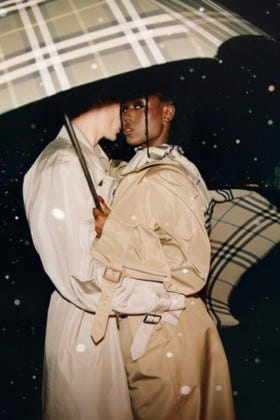Burberry's Turnaround Strategy is Working
Burberry's turnaround plan, despite initial losses, is propelling its stock higher and redefining luxury success.
The phrase “innovate or die” is heavily associated with the tech industry. Blackberry could’ve still been on top had they not gotten too comfortable with their success in the early 2000s. Skype could’ve still been on everyone’s computer had Microsoft been more aggressive post acquisition. Sega could’ve still been in everyone’s house had they not made the wrong strategic moves. The same is true for clothing companies. So many of the hottest brands ride waves of popularity for too long and rest on their laurels until it’s too late. On the opposite end, you can also go too over the top with innovation and stray too far from your core competencies, and that’s exactly what happened to one of London’s oldest fashion houses. Profits were down across the board and they needed to make some significant changes, or face dire consequences.
Last year the board decided to part ways with the former CEO, Jonathan Akeroyd after 3 years. On Akeroyd’s way out, their US and APAC markets (two geographies that plenty of luxury brands can usually depend on) saw steep declines in sales along with a drop in the Middle East, India, and Africa. They’ve arguably taken a larger hit during this luxury slowdown than some of their competitors. He also failed at raising their stock price, which had declined 40% since 2019. Joshua Schulman, the new CEO who has previously led companies like Jimmy Choo, Michael Kors, Coach, and Bergdorf Goodman, knew he had to make some aggressive changes in order to get the company back on course. “Burberry Forward,” the official name of the company’s turnaround strategy, which contains the following pillars:
Timeless British Luxury
Lead with Outerwear and earn authority in other categories
Align Distribution with customer and product strategy
Reignite a high performing culture
These are the focus areas that, if executed properly, Schulman believes will bring the brand back to its prominence (and relevance) within luxury.
Cutting Costs
Anytime turnaround efforts begin, cost cutting measures are soon to follow. Unfortunately employees can be near the top of a company’s highest expenditures and people working in non-revenue generating teams are first on the chopping block. Burberry has publicly stated it plans to cut 1,700 jobs (20% of its workforce). Ensuring retail staff are working during high traffic times will lead to a drastic reduction of hours and elimination of team members. Some of their UK factories have also been operating at overcapacity, which the company will clean up over the next several months and halt overtime and night shifts. Combined with their previous cost cutting measures prior to Burberry Forward, they expect to see an annualized savings of £100m by Spring 2027.1
Changes in Marketing
Jessica Quillin of Fashion Strategy Weekly covered a fireside chat with Joshua Schulman at the National Retail Federation (NRF) Conference back in January. “One of the most fascinating insights of Schulman’s session was his discussion of their customer personas. To build a customer-centric strategy, the Burberry teams ‘introduced a framework at [their] first townhall in August of 2024.’ The focus was on five core customer archetypes—the opinionated, the hedonist, the conservative, the investors, and the aspiring. In this discussion, they ‘identified where [they] had made progress … but [also who they] had left … behind.2’ As they get back to basics with their marketing strategy, honing in these customer personas, how and what they purchase, and what percentage they contribute to the brand’s overall revenue will allow them to better shape their messaging. They want to lean into their British roots but it still needs to deeply resonate with these segments. Burberry also went through a digital transformation across web and mobile a few years ago that was celebrated throughout the fashion industry and will still be utilized with these new campaigns.
But not everything is going through a shift. They’re still on their A game with dressing celebrities during fashion’s hottest events. Angela Bassett, Jalen Hurts and his wife, Law Roach, Cardi B, Meg the Stallion, Andre 3000, Jodie Turner-Smith, and Liu Wen were all styled by the brand at this year’s Met Gala and nailed the Black Dandy theme. If you didn’t get a chance to see the gala earlier this month, Black Dandy represents the loud style statements that the black community has made over the years and its impact on the world of fashion.

Shifts in Product Focuses
While it was admirable for a legacy brand to try new things over the last several years, their efforts fell short. They’ll be going back to focusing on coats and scarves instead of bags and shoes. “‘We took pricing too high across the board,’ Schulman told investors and analysts, setting out his assessment of what went wrong at Burberry. ‘We created new brand codes... that were not familiar or recognizable for our customers.3’” From a pricing standpoint, they’ll aim to include lower priced items in their arsenal, which should double as an offset of weak customer sentiments around luxury today as well as bring more aspirational customers into the fold.
The great news is that the market is already embracing Burberry Forward with open arms. The brand saw their stock jump by 20% back in November when this was originally announced, and then popped up another 15% after the sharing of their year end preliminary results. This is a fantastic sign for them, but also a signal to other brands that doing something that really resonates with your customers can help weather the rest of this year and beyond.
BBC; Burberry to cut 1,700 jobs as designer suffers heavy losses
Fashion Strategy Weekly; Navigating Retail’s Big Show: Day 1
Reuters; Burberry puts focus back on trench coats, scarves in turnaround plan



